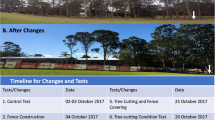Abstract
The present study evaluates the impact of lofts on the development of the navigational system of pigeons. A series of results obtained between 2000 and 2004 were analyzed. The H-loft was placed 10 m above the ground, with a ring format and seven windows all around it as well as three external aviaries that allowed birds to have a wide view of the outdoors and of the sky and knowledge of the wind dynamics. The L-loft was placed at ground level, with a single window transformed into an external aviary. The L-loft was protected from the wind by surrounding trees, reducing the ability of the pigeons to access the wind dynamics and also restricting their access to information regarding the outside area and the sky. In a preliminary analysis, we found the parameter of “vanishing time” to differ significantly between lofts in two of the five age classes. A thorough analysis of this parameter throughout the ontogenetic development of the birds demonstrated a pronounced improvement in the information-processing system with age, with adults vanishing quicker than younger birds, although an impairment of development occurred during the third month of age, perhaps due to a reorganization of the system. This result was obtained when the effect of lofts was considered in the different age classes. Results suggest that loft features are an important factor in the ability of the young pigeons to exploit navigational cues.



Similar content being viewed by others
References
Braithwaite VA, Guilford T (1995) A loft with a view: exposure to natural landscape during development may encourage adult pigeons to use visual landmarks during homing. Anim Behav 49:252–254
Braithwaite VA, Newman JA (1994) Exposure to familiar visual landmarks allows pigeons to home faster. Anim Behav 48:1482–1484
Gagliardo A, Ioalè P, Odetti F, Bingman VP (2001) The ontogeny of the homing navigational map: evidence for a sensitive learning period. Proc R Soc Lond B Biol Sci 268:197–202
Jorge P, Vicente L (in press) Light-dependent information: influence of loft conditions on young pigeon's navigational system. J Ornithol
Odeti F, Ioalè P, Gagliardo A (2003) Development of the navigational map in homing pigeons: effects of flight experience on orientation performance. Anim Behav 66:1093–1099
Papi F (2001) Animal navigation at the end of the century: a retrospect and a look forward. Ital J Zool 68:171–180
Schmidt-Koenig K (1963) On the rules of the loft, the distance and site of release in pigeon homing (the cross-loft experiment). Biol Bull 125:154–164
Walcott C (1992) Pigeons at magnetic anomalies: the effects of loft location. J Exp Biol 170:127–141
Walcott C (1996) Pigeon homing: observation, experiments and confusions. J Exp Biol 199:21–27
Walcott C, Brown I (1989) The disorientation of pigeons at Jersey Hill. The Royal Institute of Navigation (RIN 89) Orientation and Navigation Birds, Humans and other Animals, Cardiff
Wallraff HG (2004) Avian olfactory navigation: its empirical foundation and conceptual state. Anim Behav 67:189–204
Wiltschko R (1991) The role of experience in avian navigation and homing. In: Berthold P (ed) Orientation in birds. Birkhauser Verlag, Basel, pp 250–269
Wiltschko R (1992) The flying behaviour of homing pigeons, Columba livia, immediately after release. Ethology 91:279–290
Wiltschko W, Wiltschko R (1998) The navigational system of birds and its development. In: Balda RP, Pepperberg IM, Kamil AC (eds) Animal Cognition in nature, the convergence of phychology and biology in laboratory and field. Academic, San Diego, pp 155–199
Wiltschko R, Wiltschko W (2000) A strategy for beginners! Reply to Wallraff (2000). Anim Behav 60:F37–F43
Wiltschko R, Wiltschko W (2003) Avian navigation: from historical to modern concepts. Anim Behav 65:257–272
Wiltschko W, Wiltschko R, Gruter M, Kowalski U (1987) Pigeon homing: early experience determines what factors are used for navigation. Naturwissenschaften 74:196
Wiltschko R, Schopes M, Kowalski U (1989) Pigeon homing: wind exposition determines the importance of olfactory input. Naturwissenschaften 76:229–231
Zar JH (1999) Biostatistical analysis, 4th edn. Prentice Hall, New Jersey
Acknowledgements
We thank Prof. Wolfgang Wiltschko for important methodological pieces of advice. We also thank the two anonymous referees for very helpful and constructive comments on the manuscript, and we appreciate as well the improvements in English usage made by Jen Johnson through the Association of Field Ornithologists' program of editorial assistance. For logistical support, we thank Jardim Zoologico de Lisboa and Federação Portuguesa de Columbofilia. This project has been financially supported by Fundação para a Ciência e Tecnologia (PRAXIS. SFRH/BD/1126/2000).
The pigeons were bred and kept according to the Portuguese laws on animal welfare (licence no. 39086 from the Federação Portuguesa de Columbofilia).
Author information
Authors and Affiliations
Corresponding author
Additional information
Communicated by W. Wiltschko.
Rights and permissions
About this article
Cite this article
Jorge, P., Vicente, L. Loft features influence the processing of navigational information by pigeons. Behav Ecol Sociobiol 59, 397–402 (2006). https://doi.org/10.1007/s00265-005-0063-2
Received:
Revised:
Accepted:
Published:
Issue Date:
DOI: https://doi.org/10.1007/s00265-005-0063-2




